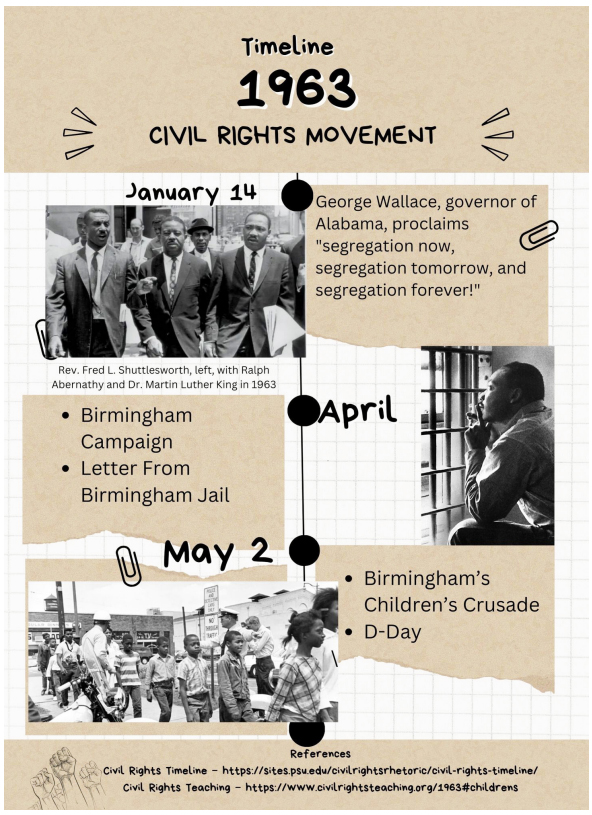1963: A Brief Timeline, January-May

Disclaimer: The views and opinions expressed in this article are those of the author and do not necessarily reflect the editors' views or any agency, organization, or employer. Based on my experience, research and knowledge, my statements are in good faith and are only for information purposes. Please research and follow up on all claims for yourself.
In terms of Civil Rights in America, 1963 was a pivotal year. This year marks just 60 years since events like the March on Washington and the "I Have a Dream" Speech, the assassination of Medgar Evers, the Bombing of the 16th Street Church, the assassination of John F. Kennedy, and many other key events in the Civil Rights Movement. These incidents helped not only motivate people to act but also led to the passing of laws that protect people from unlawful discrimination, harassment, and abuse. And now, 60 years later, where are we, and how might we learn from our past? Over the next few weeks, I will look back at 1963, explore those events, and share some thoughts on how those events can shed light on our lives today.
It's always helpful for me to see history in chronological order. It helps add context and enables me to see how one thing might cause another. I'm hoping to use the next few weeks to really show how each incident from 1963 played a part in the things that followed. Then I want to relate it to our current political and social climates and how they, in some ways, mirror the past and, in other ways, can be a tool for teaching and learning. Our history is essential in inspiring our children, promoting allyship, and influencing policy and decision-making. Hang with me over the next few weeks; let's explore, learn, and grow together.
To be honest, I knew very little about some of the things that happened in 1963, but upon learning about them, I can clearly see the connections. We will start with the inauguration of George Wallace, the racist elected governor of Alabama. On January 14, 1963, during his inaugural speech, he boasted his beliefs by proclaiming "segregation now, segregation tomorrow, and segregation forever!" Since Alabama was already one of the most racist states in the country, Reverend Fred Shuttlesworth, who founded the Alabama Christian Movement for Human Rights (ACMHR), invited Dr. Martin Luther King to come to Birmingham, Alabama, to fight against segregation. So, in April 1963, they launched the Birmingham Campaign, which included non-violent protests to end racial segregation in Birmingham. They actually taught classes and led workshops on nonviolence, how to do a sit-in, and how to protest peacefully.
On April 12, 1963, which was Good Friday that year, Dr. King was arrested during the protests, and during his stay in jail, he wrote the "Letter from the Birmingham Jail." The letter was addressed to the clergymen in Birmingham who had published a letter criticizing King and the civil rights movement. The top three points of the letter included messages about nonviolent protest, the message that justice delayed is justice denied, and a message of unity and solidarity because injustice anywhere is a threat to justice everywhere. Did you know that Dr. King was not allowed to call his wife when he was arrested? It wasn't until after his wife, Coretta Scott King, contacted President Kennedy's office that he was allowed to call her. The officials in Alabama were trifling. It took presidential inference and bail money, but Dr. King was released from jail on April 20th.I really didn't know much about the Children's Crusade of 1963; however, I am very impressed. It really was a demonstration of courage, determination, and hope. On May 2, 1963, thousands of Black children in Birmingham, Alabama, left school in protest of segregation and racial injustice. The day is sometimes referred to as D-Day or Ditch Day because many of the students walked out of school. Many of them were encouraged and coached by civil rights leaders, parents, and even teachers, knowing that many of the children would be put in jail. Their actions not only played a pivotal role in advancing civil rights but also offer us valuable lessons that can help us motivate and encourage children today.
The above-mentioned events of 1963 collectively serve as vital moments in our history. Writing about and sharing this information is a source of pride for me, but it also provides me with great insight and lessons to further understand what we are seeing today. In reflection, I see that the fight for civil rights and social justice is an ongoing journey and one that we all need to take part in. Stay tuned.
Sophia Brewer (M.L.I.S.) is Collection Development and Serials Librarian, Grand Rapids Community College; Co-President of the Greater Grand Rapids History Council; member of the Grand Rapids Study Club and serves on the Grand Rapids Public Library, Board of Library Commissioners (Elected 2016-2021). She is a former Head of Programs, Grand Rapids Public Library and former Branch Manager, Madison Square Branch, Grand Rapids Public Library Congresswoman
Tagged in: